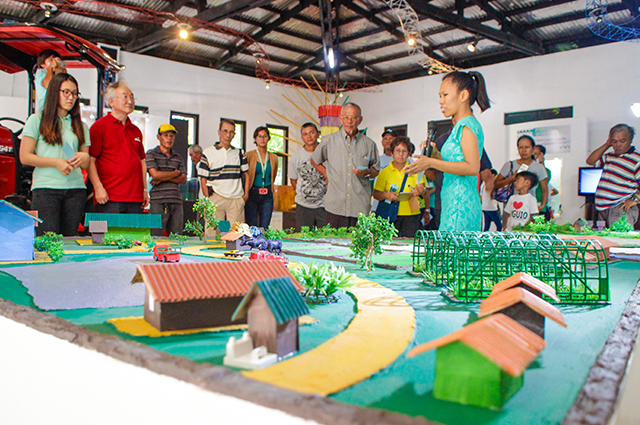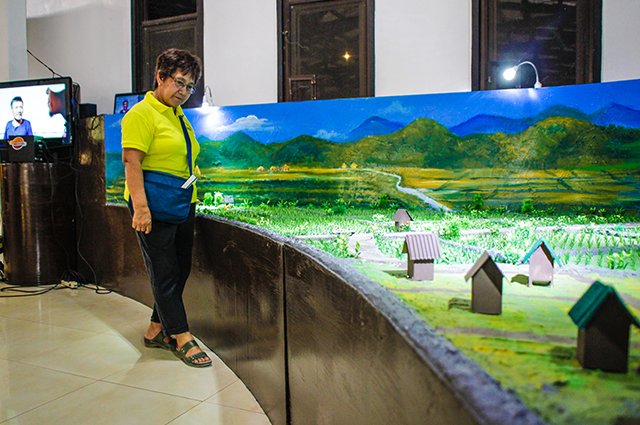 Muñoz, Nueva Ecija – In an unusual time when farmers recently formed human barricades to inform government that they are experiencing hunger owing to extreme weather conditions, the Rice Science Museum features adaptive measures on climate change in its new exhibit.
Muñoz, Nueva Ecija – In an unusual time when farmers recently formed human barricades to inform government that they are experiencing hunger owing to extreme weather conditions, the Rice Science Museum features adaptive measures on climate change in its new exhibit.
Titled Transformations in Progress, the 4th exhibit launched April 21, displays dioramas on emerging yet easy to adopt farm practices that can help farmers cope with unfavorable situations. The exhibit also presents transitions from traditional implements to machineries and from subsistence farming to farm enterprise.
Floper Gerswhin E. Manuel, museum curator, said that ecological engineering, Palayamanayon, and climate-change ready varieties are exhibited for farmers and extension workers to visualize the technologies.
Ecological engineering is a natural pest management strategy that involves planting of ornaments around the rice field to increase the number of natural enemies; resulting in lesser pesticide use. Meanwhile, Palayamanayon is a rice-based enterprise that follows the principles of diversification, intensification, and integration.
The museum houses some of the rice varieties with tolerance to saltwater intrusion, drought, and water submergence and with yield surpassing the average of 4 t/ha.
Varieties that can grow in areas with moderate amount of salt in soil or water include NSIC Rc184 (Salinas 2), Rc336 (Salinas 16), and Rc390 (Salinas 19), which can yield from 5.5-6.3 t/ha and can be harvested from 112-120 days.
NSIC Rc222, Rc288 (Sahod Ulan 10), and Rc274 (Sahod Ulan 3) are also recommended in areas where rainfall is limited or delayed. Farmers can produce 6.7-10 t/ha within 110-118 days from these varieties.
For flood-prone areas, PSB Rc18 (Ala), PSB Rc68 (Sacobia), and NSIC Rc184 (Submarino 1) are recommended. Their yields range from 3.5 to 8.1 t/ha and they mature in 112-123 days.
“Generally, we are featuring the transitions that occurred in the rice fields since the Spaniards recorded what they have witnessed on Philippine rice production. We produced this exhibit as support to the Rural Transformation Movement – a movement that aims to change tillers’ behavior on farm enterprise. For us to understand the advances on agriculture today, we must know the contexts contributing to these changes. These stories are implied on the paintings, texts, and cultural materials in the museum,” Manuel explained.
 The exhibit starts with a section celebrating the farmers’ struggles in coping with changes and their unwavering duty in providing us with food, especially with rice.
The exhibit starts with a section celebrating the farmers’ struggles in coping with changes and their unwavering duty in providing us with food, especially with rice.
“How are we thanking the farmers? And how are we consuming the rice that they produce? In this exhibit, we introduce brown rice and presents facts and misconceptions about this healthy rice. Other than the artifacts of traditional and modern farming, we also present mentifacts or the associated values and beliefs in the practices,” he said.
Research of the museum team showed that rice in the pre-conquest world was highly valued and considered the most esteemed cereal, but it was not a daily staple.
Charisma Love B. Gado, senior science research specialist and museum researcher, said rice was made into a staple food during the Spain colonization through the introduction of plow technology.
She said that rice became a commodity when the Chinese mestizos became leaseholders of rice lands in the friar haciendas. Some of these leased lands were cultivated through sharecropping agreements while others were rented out to indio peasants.
“The sources we reviewed showed that trading placed rice as ‘the only real source of wealth.’ The thinking ‘to have rice was to have everything’ was common in the 1870s,” she said.
The Americans introduced science and technology to improve rice production. To increase yields, the then Bureau of Agriculture focused on the selection of local seeds and promoted farm machinery to reduce labor costs and avert animal shortage.
“After the colonization, the technological package of Green Revolution in the 1960s turned cultivators into owner-operators of their farm. The relationship between the farmer and hired workers has become contractual and the bayanihan was no longer practiced. Cultivators’ habit of singing while planting had stopped with the advent of mechanization and paid labor,” Gado shared.
Despite the transitions and threats of climate change, Gado added that one thing had survived in the farmers lives.
“It is their faith in the Greatest Farmer – God. Farmers hold on to prayers as their weapon on dealing with changes. That without it, they find it difficult to adapt to transformations,” she said.
The Rice Science Museum based in Science City of Muñoz, Nueva Ecija will run the exhibit until September this year. The Department of Tourism-accredited museum is hosted by the Philippine Rice Research Institute (PhilRice). For visit, please contact the Visitors and Conference Services Office at 0932-867-6544.




